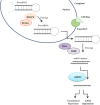From Genetics to Epigenetics: New Perspectives in Tourette Syndrome Research
- PMID: 27462201
- PMCID: PMC4940402
- DOI: 10.3389/fnins.2016.00277
From Genetics to Epigenetics: New Perspectives in Tourette Syndrome Research
Abstract
Gilles de la Tourette Syndrome (TS) is a neurodevelopmental disorder marked by the appearance of multiple involuntary motor and vocal tics. TS presents high comorbidity rates with other disorders such as attention deficit hyperactivity disorder (ADHD) and obsessive compulsive disorder (OCD). TS is highly heritable and has a complex polygenic background. However, environmental factors also play a role in the manifestation of symptoms. Different epigenetic mechanisms may represent the link between these two causalities. Epigenetic regulation has been shown to have an impact in the development of many neuropsychiatric disorders, however very little is known about its effects on Tourette Syndrome. This review provides a summary of the recent findings in genetic background of TS, followed by an overview on different epigenetic mechanisms, such as DNA methylation, histone modifications, and non-coding RNAs in the regulation of gene expression. Epigenetic studies in other neurological and psychiatric disorders are discussed along with the TS-related epigenetic findings available in the literature to date. Moreover, we are proposing that some general epigenetic mechanisms seen in other neuropsychiatric disorders may also play a role in the pathogenesis of TS.
Keywords: DNA methylation; Tourette Syndrome; epigenetics; genetics; neurological disorders; non-coding RNA; psychiatric disorders.
Figures



References
Publication types
LinkOut - more resources
Full Text Sources
Other Literature Sources

